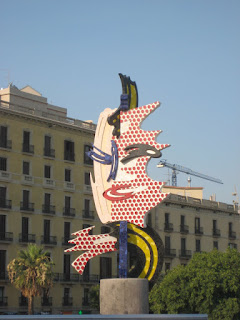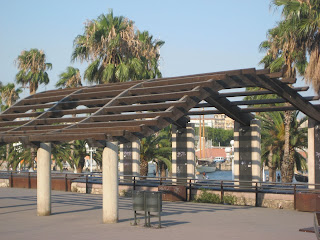Gaudi is considered to have one of the most unique and distinctive architectural styles. His work has greatly influenced the face of Barcelona Architecture and we see his work all over the city.
His work was greatly influenced by forms of nature. There is a small museum inside the Sagrada Familia that has models and photographs which explain why a particular part of the temple was designed the way it was and how it was inspired by nature. The nature aspect is reflected in his use of curved construction stones, twisted iron sculptures, and organic-like forms.
Gaudi also adorned many of his buildings with colored tiles arranged in mosaic patterns, which make them a breathtaking visual experience.
Our first stop was the Sagrada Familia which is considered to be his greatest, yet unfinished masterpiece. It has been under construction since 1882!!! (Nope…its not a typo for 1992) The construction is entirely dependent on donations and is expected to be completed around 2026.
The spindle-shaped spires of Sagrada Familia are striking. They also have another significance for me…it is seen in all Logica presentations, wallpapers!!!
The mile long queue said it all. At first glance it seems a bit ugly...guess because it’s a far cry from the traditional churches and temples...but after a few minutes one realizes that its beauty lies in its ugliness. Slowly one gets used to the sculpture and before you know it you are a fan of Gaudi and are admiring the building for its magnificence
The design has 3 facades but only 2 are complete. The Nativity facade to the East signifies the birth of Jesus. The scene of the birth of Jesus with 3 kings was very elaborately done. One can feel the happiness all around in the sculptures here.

In stark contrast to that is the Passion facade to the West which has representations from the physical, spiritual, and mental suffering faced by Jesus. The sculptures of the figures cut in straightish lines show a gaunt and tormented Jesus. The pain and suffering show on the faces of all the figures. There was one especially of a sad man which was amazing! There is also a figure of Jesus on the Crucifix which was quite impressive. The mosaic patterns on top of that seemed to have been added to act like pacifying factor.
The Glory façade to the South which is yet to be completed will represent the life and death aspects of Jesus’s life.
Next stop was the Park Guell. The bus dropped us at a place from where there was a 2 miles walk on an incline to the gates of Park Guell. Thank god for the small curio shops on the way where we took respite from the boiling sun. The only problem with that was that we ended up buying stuff which we now needed to carry with us all the way up and back!!!
Park Guell was originally planned as a garden city that combined housing and a park area since Guell was apparently enchanted with the English gardens and also wanted to re-create this in Barcelona. The design was integrated with the surroundings so the viaducts, containment walls, and twisting columns are all covered with colourful mosaics.

There is an enormous staircase that leads to the park. The stairs are decorated with waterfalls and sculptures depicting animals. The most outstanding one is the small, multicolored mosaic covered dragon.
Inside the park, is the Hall of a Hundred Columns with the most beautiful roof which seems perfect for some ball room dancing!!! But on that hot sunny day it was the haven that all the tourists were looking for – more so as the noise from traffic was almost inaudible here. The columns hold up the enormous square from where one can enjoy some of the most spectacular views of the city.
From the square there is a nice, winding corridor which leads to the house that Gaudi built for himself that has now been converted into a museum. The corridor has a very ancient look…the walls and columns looked like just stacks of stones.
The other interesting Gaudi buildings were the Casa Batlo and La Pedrera.




